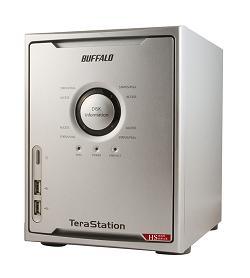
A Buffalo Terastation™ high-performance NAS.
Firmware corruption can render your LinkStation 520D unresponsive, inaccessible, or prone to erratic behavior. In most cases, you can update the firmware using Buffalo’s utilities; however, in some circumstances, firmware updates may fail if the NAS is encountering hardware issues.
You should only attempt firmware recovery on a NAS if you have a full, functional backup of all of the important data on the device. Firmware updates will not fix hardware problems — if you’re dealing with hard drive/SSD failures past the point of redundancy, contact a professional data recovery provider as soon as possible.
Likewise, if your only copy of important data is on a failed Buffalo NAS, the best course of action is to work with a professional data recovery laboratory. Failed NAS rebuilds can cause permanent data loss.
With those caveats in mind, let’s look at the process for restoring firmware on an otherwise functional NAS. This process is accurate as of November 2024.
The LinkStation 500 Series Firmware Update Process
You may need to update the firmware if your NAS is operating in Emergency Mode (or if the firmware is simply out of date). The process is fairly straightforward:
- Download the Recovery Firmware: Navigate to the Buffalo website, hover over the “Support” and type in your LinkStation model (e.g., LS520DN0202). Download the corresponding recovery firmware image file, typically in .img format. This image contains a minimal bootable system with the necessary tools to restore the NAS firmware.
- Prepare a USB Drive: Format a USB flash drive with a capacity of 2GB or less using the FAT32 file system. This ensures compatibility with the LinkStation’s boot process.
- Copy the Firmware Image: Copy the downloaded .img file to the root directory of the formatted USB drive.
- Power Off the LinkStation: Ensure the device is completely shut down to avoid any potential data corruption during the recovery process.
- Connect the USB Drive: Insert the USB drive into the USB port located on the back panel of the LinkStation.
- Power On and Initiate Recovery: While holding down the function button (usually a small recessed button on the back panel), power on the LinkStation. Continue holding the function button until the status LED begins blinking, indicating that the device is entering recovery mode.
- Wait for Firmware Recovery: The LinkStation will automatically detect the recovery firmware image on the USB drive. It will then initiate the process of validating the image and writing it to the flash memory. This may take several minutes, during which the status LED will continue blinking. It’s crucial not to interrupt this process, as it could further corrupt the firmware.
- Final Steps: Once the status LED stops blinking and remains steadily lit, the firmware recovery is complete. Power off the LinkStation, remove the USB drive, and then power it on again. The device should now boot with the restored firmware.
Understanding Firmware Corruption
Buffalo NAS devices are reliable, but every storage system is susceptible to hardware and software issues. On NAS devices, several factors can contribute to firmware corruption:
- Failed firmware updates: The update process involves overwriting the existing firmware with a new version. If interrupted by power outages, network instability, or unexpected errors, the firmware image can become incomplete or corrupted, leading to boot failures or operational instability.
- Faulty hardware: Flash memory, where the firmware is stored, can degrade over time or become damaged due to electrical surges or manufacturing defects. Remember, firmware updates won’t fix hardware issues — if you suspect a hardware failure, replace the NAS.
- Power surges: Sudden spikes in voltage can disrupt the delicate electronic components within the NAS, potentially altering or erasing sections of the
RAID is Not a Backup: Why a Separate Backup is Crucial
Buffalo NAS systems use various configurations for storing data, including RAID 1, RAID 0, and RAID 5. RAID adds redundancy, but if data exists on a single physical storage device, data loss is always a possibility.
The LinkStation 520D typically employs RAID 1 (mirroring), where identical data is written to both drives in the NAS. This provides redundancy against a single drive failure. However, RAID offers no protection against firmware corruption or other types of logical errors, which can affect both drives simultaneously.
Before attempting any firmware recovery, it’s imperative to have a complete and verified backup of your data. If you lack a backup and your data is inaccessible, treat this as a critical data recovery scenario. Proceed with extreme caution and consider seeking professional help.
Data Recovery Solutions for Buffalo NAS Systems
Datarecovery.com operates full-service laboratories at every location. Our engineers can provide fast answers for NAS errors — and provide peace of mind throughout the process via our no data, no charge guarantee.
Recover data from any NAS device. Call 1-800-237-4200 or submit a case online to schedule a risk-free evaluation.




